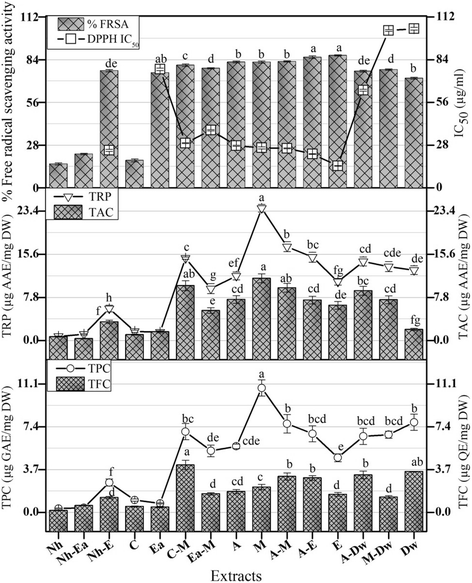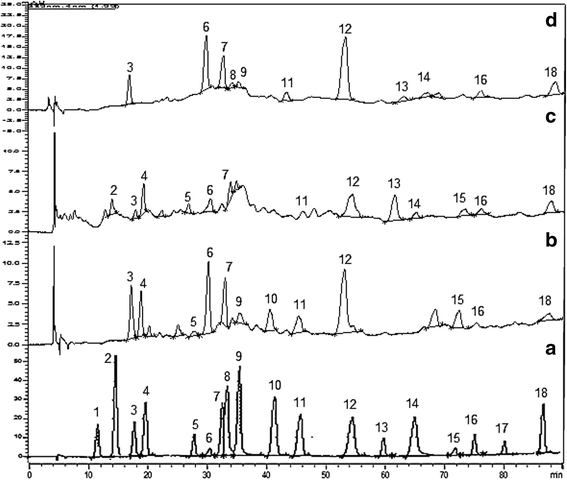Polarity based characterization of biologically active extracts of Ajuga bracteosa Wall. ex Benth. and RP-HPLC analysis
- PMID: 28870197
- PMCID: PMC5583766
- DOI: 10.1186/s12906-017-1951-5
Polarity based characterization of biologically active extracts of Ajuga bracteosa Wall. ex Benth. and RP-HPLC analysis
Abstract
Background: The concept of botanical therapeutics has revitalized due to wide importance of plant derived pharmaceuticals. Therefore, the ameliorative characteristics of Ajuga bracteosa were studied.
Methods: Total phenolic content, flavonoid content, antioxidant capacity, reducing power and free-radical scavenging activity were determined colorimetrically. Specific polyphenols were quantified by RP-HPLC analysis. Preliminary cytotoxicity was tested using brine shrimp lethality assay while antiproliferative activity against THP-1 and Hep-G2 cell lines was determined by MTT and SRB protocols respectively. Antileishmanial potential was assessed via MTT colorimetric method. To investigate antidiabetic prospect, α-amylase inhibition assay was adopted whereas disc diffusion method was used to detect likely protein kinase inhibitory, antibacterial and antifungal activities.
Results: Among fifteen different extracts, maximum total phenolic content (10.75 ± 0.70 μg GAE/mg DW), total reducing power (23.90 ± 0.70 μg AAE/mg DW) and total antioxidant capacity (11.30 ± 0.80 μg AAE/mg DW) were exhibited by methanol extract with superlative percent extract recovery (17.50 ± 0.80% w/w). Chloroform-methanol extract demonstrated maximum flavonoid content (4.10 ± 0.40 μg QE/mg DW) and ethanol extract exhibited greatest radical scavenging activity (IC50 14.40 ± 0.20 μg/ml). RP-HPLC based quantification confirmed polyphenols such as pyrocatechol, gallic acid, resorcinol, catechin, chlorogenic acid, caffeic acid, syringic acid, p-coumaric acid, ferulic acid, vanillic acid, coumarin, sinapinic acid, trans-cinnamic acid, rutin, quercetin and kaempferol. The brine shrimp lethality assay ranked 78.60% extracts as cytotoxic (LC50 ≤ 250 μg/ml) whereas significant THP-1 inhibition was shown by methanol-acetone extract (IC50 4.70 ± 0.43 μg/ml). The antiproliferative activity against Hep-G2 hepatoma cancer cell line was demonstrated by n-hexane, ethylacetate and methanol-distilled water (IC50 8.65-8.95 μg/ml) extracts. Methanol extract displayed prominent protein kinase inhibitory activity (MIC 12.5 μg/disc) while n-hexane extract revealed remarkable antileishmanial activity (IC50 4.69 ± 0.01 μg/ml). The antidiabetic potential was confirmed by n-hexane extract (44.70 ± 0.30% α-amylase inhibition at 200 μg/ml concentration) while a moderate antibacterial and antifungal activities were unveiled.
Conclusion: The variation in biological spectrum resulted due to use of multiple solvent systems for extraction. We also deduce that the valuable information gathered can be utilized for discovery of anticancer, antileishmanial, antioxidant and antidiabetic bioactive lead candidates.
Keywords: Ajuga Bracteosa; Antiproliferative activity; Hep G2 hepatoma cell line; Leishmania tropica; Protein kinase inhibition; THP-1 human leukemia cell line.
Conflict of interest statement
Ethics approval and consent to participate
Not applicable
Consent for publication
Not applicable
Competing interest
The authors declare that they have no competing interests.
Publisher’s Note
Springer Nature remains neutral with regard to jurisdictional claims in published maps and institutional affiliations.
Figures





Similar articles
-
Polarity directed optimization of phytochemical and in vitro biological potential of an indigenous folklore: Quercus dilatata Lindl. ex Royle.BMC Complement Altern Med. 2017 Aug 3;17(1):386. doi: 10.1186/s12906-017-1894-x. BMC Complement Altern Med. 2017. PMID: 28774308 Free PMC article.
-
Appraisal of phytochemical and in vitro biological attributes of an unexplored folklore: Rhus Punjabensis Stewart.BMC Complement Altern Med. 2017 Mar 9;17(1):146. doi: 10.1186/s12906-017-1659-6. BMC Complement Altern Med. 2017. PMID: 28274230 Free PMC article.
-
Extraction optimization of medicinally important metabolites from Datura innoxia Mill.: an in vitro biological and phytochemical investigation.BMC Complement Altern Med. 2015 Oct 19;15:376. doi: 10.1186/s12906-015-0891-1. BMC Complement Altern Med. 2015. PMID: 26481652 Free PMC article.
-
Blackthorn-A Valuable Source of Phenolic Antioxidants with Potential Health Benefits.Molecules. 2023 Apr 14;28(8):3456. doi: 10.3390/molecules28083456. Molecules. 2023. PMID: 37110690 Free PMC article. Review.
-
Unrevealing the mechanisms behind the cardioprotective effect of wheat polyphenolics.Arch Toxicol. 2024 Nov;98(11):3543-3567. doi: 10.1007/s00204-024-03850-y. Epub 2024 Aug 31. Arch Toxicol. 2024. PMID: 39215839 Review.
Cited by
-
Green Bio-Assisted Synthesis, Characterization and Biological Evaluation of Biocompatible ZnO NPs Synthesized from Different Tissues of Milk Thistle (Silybum marianum).Nanomaterials (Basel). 2019 Aug 16;9(8):1171. doi: 10.3390/nano9081171. Nanomaterials (Basel). 2019. PMID: 31426328 Free PMC article.
-
Biological Activities of In-House Developed Haloxylon griffithii Plant Extract Formulations.Plants (Basel). 2021 Jul 13;10(7):1427. doi: 10.3390/plants10071427. Plants (Basel). 2021. PMID: 34371630 Free PMC article.
-
Sustainable Production of Ajuga Bioactive Metabolites Using Cell Culture Technologies: A Review.Nutrients. 2023 Mar 1;15(5):1246. doi: 10.3390/nu15051246. Nutrients. 2023. PMID: 36904246 Free PMC article. Review.
-
Synthesis, crystal structure, Hirshfeld surface investigation and comparative DFT studies of ethyl 2-[2-(2-nitrobenzylidene)hydrazinyl]thiazole-4-carboxylate.BMC Chem. 2022 Mar 22;16(1):18. doi: 10.1186/s13065-022-00805-1. BMC Chem. 2022. PMID: 35317817 Free PMC article.
-
Bio-Assisted Synthesis and Characterization of Zinc Oxide Nanoparticles from Lepidium sativum and Their Potent Antioxidant, Antibacterial and Anticancer Activities.Biomolecules. 2022 Jun 20;12(6):855. doi: 10.3390/biom12060855. Biomolecules. 2022. PMID: 35740980 Free PMC article.
References
-
- Patil D. Ethnomedicine to modern medicine: genesis through ages. J Exp Sci. 2011;2:25–29.
-
- Jan M, Singh S, Kaloo ZA, Maqbool F. Medicinal importance of Ajuga bracteosa wall ex Benth. – A review. Inter J Adv Res. 2014;2:389–394.
MeSH terms
Substances
LinkOut - more resources
Full Text Sources
Other Literature Sources
Molecular Biology Databases
Research Materials

